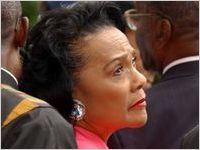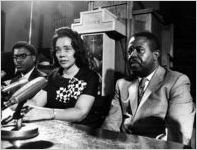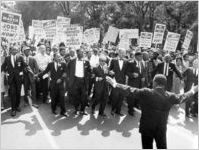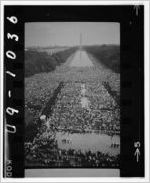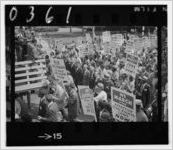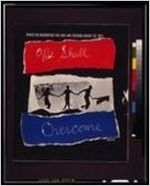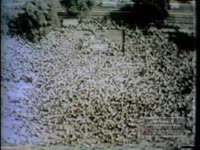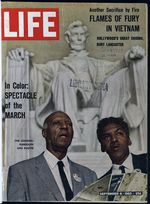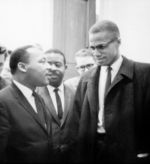March on Washington
- Title:
- March on Washington
- Years:
- 1963
- Description:
- On August 28, 1963, a quarter of a million Americans from across the United States converged on the nation's capitol in what was to become a defining moment in the Civil Rights movement. Plans for the March on Washington for Jobs and Freedom began in 1962 when A. Philip Randolph, founder of the Brotherhood of Sleeping Car Porters, put forth the idea of a mass gathering on Washington, D.C. to draw attention to the economic plight of the county's African American population. Randolph called upon the nation's leading civil rights organizations to lend their support to the march and persuaded President John F. Kennedy to endorse the demonstration. As plans progressed, Randolph charged noted civil rights activist, Bayard Rustin, with the arduous task of coordinating and directing the logistics for the march. Rustin and his crew of volunteers worked around the clock to make necessary arrangements as word of the upcoming march spread throughout the country, and thousands of anxious supporters prepared to make their descent on the nation's capitol. On August 28, 1963, a crowd of 250,000 people, including nearly 450 members of Congress, gathered at Lincoln Memorial to listen to the day's scheduled performances and speeches. Randolph along with Roy Wilkins, John Lewis and others delivered riveting speeches before Martin Luther King took his place at the podium and delivered his famous "I Have a Dream" speech. Even though the March on Washington succeeded in both dramatizing and politicizing the need to secure federal legislation banning segregation and racial discrimination, it would be another year before King's dream was realized with the 1964 passage of the Civil Rights Act.
- Archival Collections And Reference Resources:
-
16 items in 8 collections (expand all)
"Why should we march?" March on Washington fliers
- Creator:
- March on Washington Movement
- Date of Original:
- 1941
- Collection:
- African American Odyssey
- Contributing Institution:
- Library of Congress
March on Washington, August 28, 1963
- Date of Original:
- 1963-08-23
- Collection:
- African American Odyssey
- Contributing Institution:
- Library of Congress
--I go for all sharing the privileges of government who assist in bearing its burden! Lincoln / Baldy, [1963 Aug. 28]
- Creator:
- Baldowski, Clifford H., 1917-1999
- Date of Original:
- 1963-08-28
- Collection:
- Baldy Editorial Cartoons, 1946-1982, 1997: Clifford H. Baldowski Editorial Cartoons at the Richard B. Russell Library.
- Contributing Institution:
- Richard B. Russell Library for Political Research and Studies
Coretta Scott King
- Creator:
- Uffelman, Minoa D.
- Date of Original:
- 2008-03-12
- Collection:
- Encyclopedia of Alabama
- Contributing Institution:
- Encyclopedia of Alabama (Project)
1 Orville Pitts letter, 1965 July 13
- Creator:
- Milwaukee United School Integration Committee
- Date of Original:
- 1965-07-13
- Collection:
- March on Milwaukee: Civil Rights History Project
- Contributing Institution:
- Wisconsin Historical Society
Coretta Scott King (1927-2006)
- Creator:
- McCarty, Laura
- Date of Original:
- 2006-11-03
- Collection:
- New Georgia Encyclopedia
- Contributing Institution:
- New Georgia Encyclopedia (Project)
Freedom Singers
- Creator:
- Hatfield, Edward A.
- Date of Original:
- 2007-11-02
- Collection:
- New Georgia Encyclopedia
- Contributing Institution:
- New Georgia Encyclopedia (Project)
March on Washington
- Creator:
- Rowe, Abbie
Marion S. Trikosko - Date of Original:
- 1963
- Collection:
- New Georgia Encyclopedia
- Contributing Institution:
- New Georgia Encyclopedia (Project)
March on Washington
- Date of Original:
- 1963
- Collection:
- New Georgia Encyclopedia
- Contributing Institution:
- New Georgia Encyclopedia (Project)
Civil rights march on Washington, D.C.
- Creator:
- Leffler, Warren K.
- Date of Original:
- 1963-08-28
- Collection:
- Voices of Civil Rights
- Contributing Institution:
- Library of Congress
Civil rights march on Washington, D.C.
- Creator:
- Leffler, Warren K.
- Date of Original:
- 1963-08-28
- Collection:
- Voices of Civil Rights
- Contributing Institution:
- Library of Congress
Cleveland Robinson, full-length portrait, facing front, standing on second floor balcony of the National Headquarters of the March on Washington in Harlem, with his arm lifted up toward banner announcing the march
- Creator:
- Fernandez, Orlando
- Date of Original:
- 1963
- Collection:
- Voices of Civil Rights
- Contributing Institution:
- Library of Congress
We shall overcome March on Washington for Jobs and Freedom, August 28, 1963
- Creator:
- Lo Monaco, Louis
- Date of Original:
- 1963
- Collection:
- Voices of Civil Rights
- Contributing Institution:
- Library of Congress
Martin Luther King, Jr. leads freedom march at Washington Monument (August 28, 1963). King receives Nobel Peace Prize (December 10, 1964).
- Creator:
- WSB-TV (Television station : Atlanta, Ga.)
- Date of Original:
- 1948/1981
- Collection:
- WSB-TV Newsfilm Collection
- Contributing Institution:
- Walter J. Brown Media Archives and Peabody Awards Collection
WSB-TV newsfilm clip of Dr. Martin Luther King, Jr. encouraging participation in the March on Washington, 1963
- Creator:
- WSB-TV (Television station : Atlanta, Ga.)
- Date of Original:
- 1963-00-00
- Collection:
- WSB-TV Newsfilm Collection
- Contributing Institution:
- Walter J. Brown Media Archives and Peabody Awards Collection
Life magazine, September 6, 1963
- Date of Original:
- 1963-09-06
- Collection:
- With an Even Hand: Brown vs. Board at Fifty
- Contributing Institution:
- Library of Congress
- Educator Resources:
-
4 items in 3 collections (expand all)
Amistad Digital Resource for Teaching African American History
- Date of Original:
- 1954/1975
- Collection:
- Amistad Digital Resource for Teaching African American History
- Contributing Institution:
- Columbia Center for Digital Research and Scholarship
SNCC 1960-1966 : Six years of the Student Nonviolent Coordinating Committee
- Date of Original:
- 1960/1966
- Collection:
- SNCC 1960-1966 : Six Years of the Student Nonviolent Coordinating Committee
- Contributing Institution:
- University of North Carolina at Chapel Hill
Excerpts from the March on Washington, part 3
- Date of Original:
- 1941/1964
- Collection:
- Teachers' Domain Civil Rights Special Collection
- Contributing Institution:
- WGBH Educational Foundation
March on Washington flyers
- Creator:
- WGBH Educational Foundation
- Date of Original:
- 1950/1963
- Collection:
- Teachers' Domain Civil Rights Special Collection
- Contributing Institution:
- Birmingham Civil Rights Institute (Birmingham, Ala.)
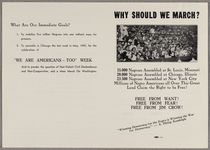
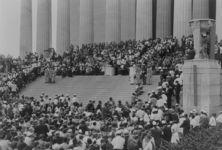
![--I go for all sharing the privileges of government who assist in bearing its burden! Lincoln / Baldy, [1963 Aug. 28]](https://crdl.usg.edu/thumbnails/dlg/bald/dlg_bald_am-1567.jpg)
